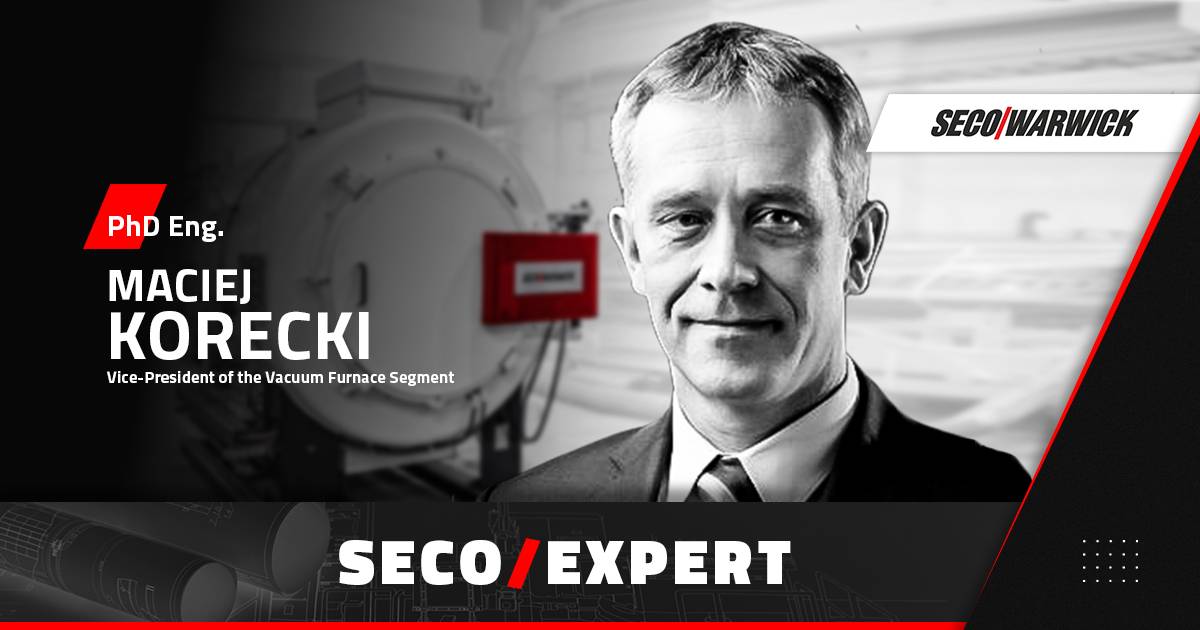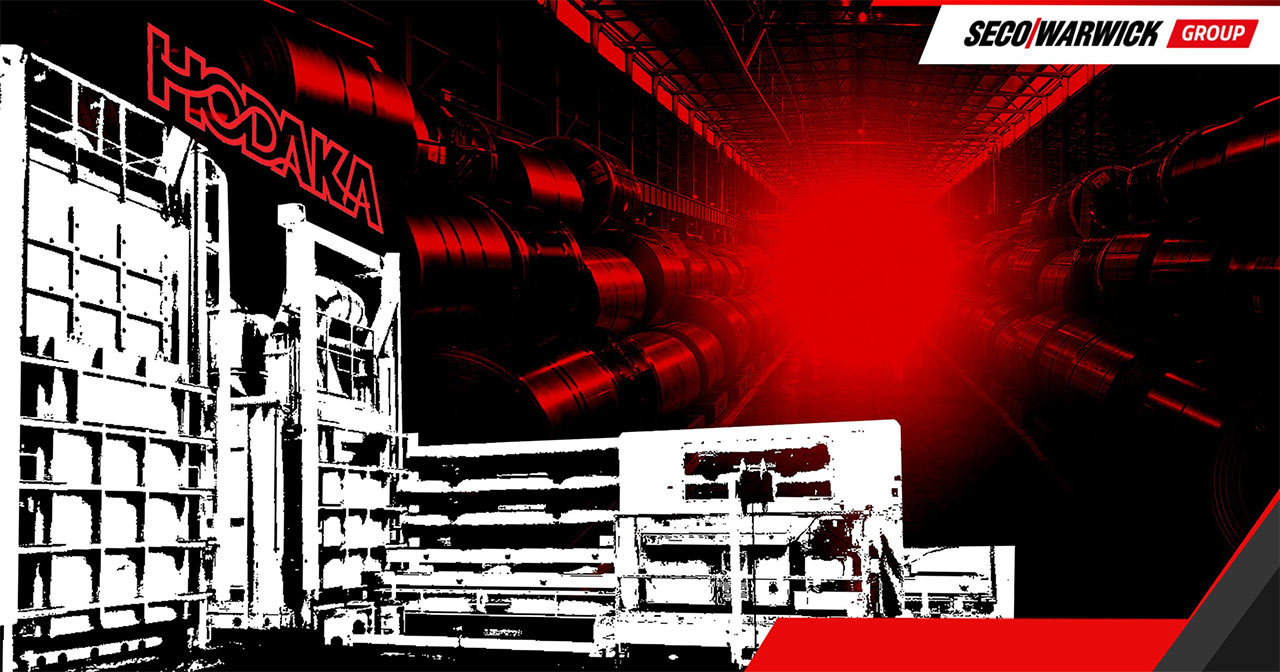A process that has been known for more than a century, gas nitriding, has seen a technology breakthrough that is a real game changer in the field of metal heat treatment. The ZeroFlow® method introduced to global industry by SECO/WARWICK in cooperation with scientists from one of the best technical universities in Poland, Poznan University of Technology, reduces process costs with performance that is far more ecologically friendly.
The reason why ZeroFlow® furnaces with nitriding technology are such a great technological revolution is that so many industries can benefit from this method, says inventor and promoter of modern heat treatment, Maciej Korecki, PhD Eng., Vice President of the Vacuum Furnace Segment at SECO/WARWICK Group.
Gas nitriding of steel is a process that is over 100 years old. What did the process look like in the past and what does it look like today?
Maciej Korecki: It’s true. Nitriding is one of the most widely used thermochemical treatment processes for producing surface hardened layers. Today it is used wherever steel parts are manufactured, for example, gears, bushings, shafts, dies, punches or molds, used mainly in the machinery, automotive, aerospace, mining or toolmaking industries.
Historically, it began with nitriding in pure ammonia, but difficulties were encountered in controlling and reproducing process results. Various gases were then added to the ammonia for over 100 years until the present to control the process, which improved the results. Today, gas nitriding uses a composition-controlled mixture of ammonia and diluent gases, primarily in the form of dissociated ammonia or nitrogen to control the nitrogen potential, which is the primary driver of the nitriding process. A characteristic feature is a need for a continuous flow of atmosphere through the furnace, that is, inflow and outflow. The latest technological development in this process is ZeroFlow® gas nitriding. It is a method that significantly reduces process costs while protecting the environment.
What is ZeroFlow® gas nitriding?
M.K.: ZeroFlow nitriding is ammonia-based gas nitriding. It is distinguished by the fact that the nitrogen potential is controlled by introducing the right portion of ammonia at the right time and only ammonia, instead of a continuous flow of a mixture of ammonia and diluent gas. Consequently, the ZeroFlow method uses the minimum amount of ammonia needed to achieve the required nitrogen potential and replenish the nitrogen in the atmosphere, taking into account the situation where no ammonia is supplied to the furnace at all, no flow, hence the suggestive name of the solution, ZeroFlow. Using ammonia alone in the nitriding process, we are dealing with a stoichiometric reaction (as opposed to some traditional methods), that is, one that is uniquely defined and predictable based on the monitoring of a single component of the atmosphere. Therefore, the ZeroFlow process controls very precisely through the analyzer only one gas, obtaining an improvement in the quality and repeatability of the results compared to various traditional methods.
Where did the idea for ZeroFlow come from, and how long has SECO/WARWICK been working on this technology?
M.K.: ZeroFlow can be said to go back to the source, to the basics of the nitriding process, by using ammonia alone without any additional gases. The inventor of the method is prof. Leszek Maldzinski of the Poznan University of Technology, who developed the theoretical basis and confirmed it with research. Then, more than 10 years ago, a partnership between SECO/WARWICK and the Poznan University of Technology initiated a project to develop and build the first industrial furnace designed to perform the ZeroFlow nitriding processes. The furnace was launched at SECO/WARWICK’s research and development department (SECO/LAB®), where the method has been implemented and validated on dozens of industrial-scale processes. The project lasted several years and involved dozens of our engineers and researchers from the Poznan University of Technology.
Does ZeroFlow® nitriding produce the same results as other gas nitriding methods?
M.K.: Definitely yes. The ZeroFlow method is a complete and versatile alternative to any gas nitriding process. A layer of any structure and thickness can be produced and various technological options such as ferritic nitrocarburizing and oxidation can be realized. At the same time, it is a method that provides great benefits to those who choose to use it. The most important advantage is the minimization of ammonia consumption and post-process gas emissions. Simplified gas and measurement installation and increased process control accuracy translates directly into reduced process costs and environmental care, while improving production quality.
What affects the gas requirements and the cost of nitriding processes?
M.K.: When it comes to costs, the main influences are the energy consumption to achieve and maintain the elevated process temperature and the nitriding gases. Gas demand is mainly influenced by the method and quality of nitrogen potential control. In traditional solutions, a given nitrogen potential is obtained by applying a continuous flow of atmosphere in an amount resulting from the method adopted and the furnace condition, generally with a large excess compared to the charge demand. This can be compared to maintaining a constant water level in a leaky bucket, where there must be a continuous supply of water depending on the size of the hole. The ZeroFlow method uses the optimum and minimum amount of ammonia necessary to deliver the required amount of nitrogen to the surface of the machined parts. In this case, the bucket is sealed and there is no leakage. In fact, one of our customers, a renowned automotive company, used about 160 tons of ammonia per year in its traditional nitriding processes. After ZeroFlow was implemented, consumption dropped to about 20 tons per year. This represents a reduction in ammonia consumption of up to 87.5%.
Does this mean that ZeroFlow nitriding is both economical and an environmentally friendly process?
M.K.: Definitely yes. It uses many times less ammonia, one of the main cost factors of the process, and similarly emits many times fewer exhaust gases including, ultimately, nitrogen oxides (NOx), making ZeroFlow significantly more environmentally friendly.
About the guest
Maciej Korecki is a graduate of Zielonogórski University, where he received a Master of Science degree in Electrical Engineering in 1988. He earned the academic degree of PhD Eng. at the Mechanical Department of the Technical University of Łódź in 2008 in the field of vacuum furnace design and testing. He is the author of numerous international SECO/WARWICK patents and regularly holds technical lectures at international conferences, specializing in vacuum heat treatment technology. His career started in Elterma in 1988 as a vacuum furnace service engineer. In 1991, he joined SECO/WARWICK where he gained competencies in the techniques and processes as well as development and innovation, specializing in vacuum carburizing and high-pressure gas quenching.
Currently, he is the Vice-President of Vacuum Furnace Segment, appointed by the Board of SECO/WARWICK in 2012. PhD Eng. Maciej Korecki actively promotes the development and improvement of vacuum heat treatment equipment and processes as well as their applications in new industry and technology areas. He is the inventor and advocate of a unique vacuum heat treatment technology, the „single-piece flow” method.



